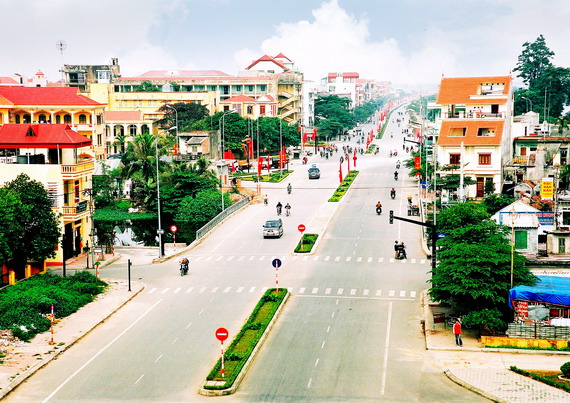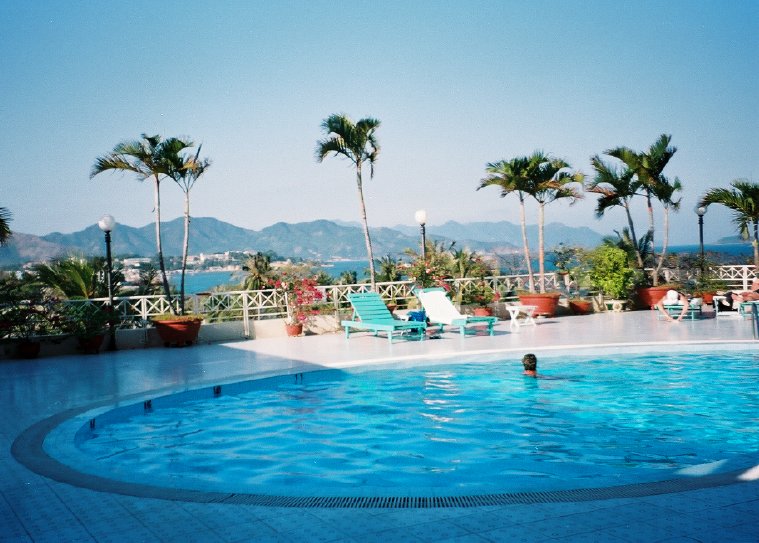INDOCHINA INTERNATIONAL CONSULTING CO., LTD
HO Add: 62L/36 Nguyên Hồng, Ward 11, Bình Thạnh District, HCMC - Vietnam
Biz Office Add: #48 Road No 11, Quarter 6, Hiệp Binh Chánh Ward, Thủ Đức, HCMC - Vietnam
®Source: http://viipip.com should be clearly quoted for any use of information extracted from our website.
Publication permit No: 60/GP-TTĐT , April 05, 2010.


Hai Duong Province.
The domestic land roads were also improved and upgraded creating a network linking with the national roads in order to take advantage of the national traffic system. 147 kilometres of provincial roads that were used to be the fifth -class roads or the non-gradated roads have been upgraded to the forth -class or the third -class roads, for example the road No 188 with An Thai Bridge, the road No 39D with Day Bridge. A number of roads such as the road 190A (connecting to 6 communes in the East of Thanh Ha district), the road No 188 (connecting to the end of Kim Thanh district), the road No 194 (connecting to Thai Duong- Binh Giang region), An Thai Bridge (connecting Kinh Mon district and the National Road No 5) were upgraded and constructed breaking the "isolation" of the local communes and districts that are surrounded by rivers.
"Ten years ago, when I had a meeting in the district centre, I had to get up early for the fear of the crowed ferry-boat. Now there is a bridge and the road is thorough, so it takes me just only 30 minutes to go there." - said a commune official in Kinh Mon district about the effectiveness of the provincial traffic system.
Along with the provincial roads, in the period 1995-2002, 133 kilometres of the lower class district roads in Hai Duong were improved and upgraded to the forth-grade delta road surfaced with asphalt and concrete. The medium and big bridges such as Di Ninh Bridge (Ninh Giang), Huong Bridge (Thanh Ha), Suoi Ca Bridge (Chi Linh), Kim Khe Bridge (Kim Thanh) were newly constructed creating a thorough land transportation network from the city to its districts and communes.
The typical feature of Hai Duong’s traffic system in the recent year has been the rapid development in rural transportation, which accounts for 95% of the total length of the whole province’s traffic network.
Never before has the motto "the state and people co-operate" brought about such a vibrant atmosphere in the improvement of the rural transportation. Since 2001, the provincial Government has supported 15-20% of the expenditure for the commune opening or improving a 2-meter upwards-wide road with brick, asphalt and broken stone or concrete. Thanks for the support, farmers in almost every commune do not hesitate to contribute to the rest expenditure. Up to now, Hai Duong has mobilised VND517 billion to invest in rural transportation. Accordingly, thousands of kilometres of rural roads including 117 km asphalt road, 1,699 km concrete-paved road and 991 km brick-paved road have been improved and upgraded which has brought about the advantages for the rural agricultural development.
The transport capacity of Hai Duong has rapidly strengthened in the recent years partly owing to the improvement and expansion of the road system. The total volume of commodity transportation of the province stood at 3.4 tons in 1997 but increased by 1.5 times to five million tonnes in 2002. Passenger transportation has experienced modest quantity increase (totally 240 buses and 1,400,000 passengers annually) but great change in quality with the system of high quality buses and trains. For water transportation alone, satisfactory investment and exploitation will probably multiple the transport capacity to millions of tons.
Waterway potentials to be effectively utilised
Hai Duong has a dense system of rivers, which used to be the major transport for the local people. The surrounding rivers connect the communes and districts and flow through Hai Duong to the near-by provinces such as Thai Binh River linking Hai Duong City, Nam Sach and Chi Linh districts with Bac Giang province; Kinh Thay River connecting Nam Sach, Kinh Mon, Kim Thanh districts and Quang Ninh, Hai Phong provinces; Sat River connecting Hai Duong city and Hung Yen, Bac Ninh provinces... Besides, a number of rivers such as Cuu An, Sat, Dinh Dao, Tu Ky, regarded as the "inner-provincial rivers" are also of great potentials. However, the waterway in Hai Duong is just being exploited naturally. A number of unimproved piers and shipyards, undredged rivers and outdated signalling equipment have hindered the capacity of water transportation. There have been 563 means of water transport in Hai Duong so far with the total capacity of 98.800 tonnes that can annually transport 2.6 million tonnes of commodities. Meanwhile, the local waterway system is capable of the operation of a far greater number of means of transport.
At present, Hai Duong has 11 waterway routes of over 264.4 km long of main rivers such as Thai Binh, Luoc and Kinh Thay Rivers and under the Government’s management. These waterway routes are considered to be a great potential creating good conditions for Hai Duong to integrate into the national economy and access to Pacific Ocean by waterways. In 2003, with the exception of the water level at alarming level 3 in the flood and storm seasons, these waterway routes kept the vehicles with the capacity of up to 200 tons travelling frequently.
If some parts of these routes are improved and dredged, the ship, ferry and barge with capacity of up to 600 tons can enter the Cong Cau port at any time of the year. In addition, there are also other six routes of 119 km in Hai Duong under the direct management of the provincial authority. At that time, due to the limited dimensions of the boat - supporting dams on these routes such as Cau Xe, Ngoc Uyen, Neo, An Tho... only the barge with capacity of under 100 tons can go through it. However, the technical standards of these waterway routes are able to allow a barge of up to 200 tons to travel on.
Apart from these above waterway routes, Hai Duong still has some others that can be used for water transportation. Such routes including 8 routes of 92 km are planning to be put under the management of the provincial authority. Because the land transportation are good enough to meet almost demand for transport in the province, the potential of Hai Duong’s water transportation has not fully been exploited. It is likely that only the construction and agriculture materials are transported by waterways. And water transportation is only taken as the most important mode of transport by Hoang Thach Cement Factory to convey their products to other provinces. With a great capacity of transport, especially for the super-long and heavy cargo, Hai Duong’s water transportation will be sure to develop once the province’s economy grows rapidly and the demand for transport increases, that will bring pressure to the land transportation.
In the future, the water transportation system in Hai Duong should be much more invested to catch up with the rapid development of its land transportation. It will contribute greatly to Hai Duong’s economy, which is getting off the ground.
- FDI capital continues to pour into Vietnam (6/11/2025 1:20:33 PM)
- Thanh Hoa receives good news: Preparing to have an additional industrial park of up to 470 hectares, creating jobs for nearly 30,000 people (6/11/2025 1:15:09 PM)
- Industrial Park Real Estate: Waiting for the New Generation of FDI (6/11/2025 1:10:15 PM)
- A wealthy Vietnamese city will have two special economic zones after the merger (6/11/2025 1:04:42 PM)
- 30 billion USD capital FDI in Việt Nam by 2025, a series of "ông big" races to expand the land fund (6/11/2025 12:55:26 PM)
- the 2nd largest city in the North will start construction on an international economic zone (6/11/2025 12:50:20 PM)
- Japanese giant Sumitomo continues to want to build an industrial park in the countrys fourth smallest province. (6/11/2025 12:40:45 PM)
- 3 foreign corporations want to invest billions of dollars in Ba Ria - Vung Tau (6/11/2025 12:34:30 PM)
- Lotte Group member starts construction of nearly 1,000 billion VND logistics center in the province with the most industrial parks in Vietnam (6/11/2025 12:33:26 PM)
- Forming a regional center for manufacturing spare parts and components (6/11/2025 12:24:08 PM)
- Vietnams first wafer factory is about to start construction (6/11/2025 12:19:09 PM)
- Dong Nai attracts foreign investors (6/11/2025 12:13:27 PM)
- Tay Ninhs largest industrial park welcomes a $150 million high-end knitted fabric factory project (6/11/2025 12:11:00 PM)
- (6/11/2025 12:09:10 PM)
- Vietnam will become a destination for Chinese investors in the future (11/6/2023 1:03:19 PM)

- FDI capital continues to pour into Vietnam
- Thanh Hoa receives good news: Preparing to have an additional industrial park of up to 470 hectares, creating jobs for nearly 30,000 people
- Industrial Park Real Estate: Waiting for the New Generation of FDI
- A wealthy Vietnamese city will have two special economic zones after the merger
- 30 billion USD capital FDI in Việt Nam by 2025, a series of "ông big" races to expand the land fund










 ADB: Vietnam’s 2009 GDP growth to be highest in South East Asia
ADB: Vietnam’s 2009 GDP growth to be highest in South East Asia MGM Grand Ho Tram: Vietnam’s First ‘Las Vegas Style’ Integrated Resort
MGM Grand Ho Tram: Vietnam’s First ‘Las Vegas Style’ Integrated Resort Nha Trang’s Twin Towers project licenced
Nha Trang’s Twin Towers project licenced Foreign investors still have good opportunities in Vietnam
Foreign investors still have good opportunities in Vietnam Sierra Wireless gets a foot in Vietnam’s ICT market
Sierra Wireless gets a foot in Vietnam’s ICT market